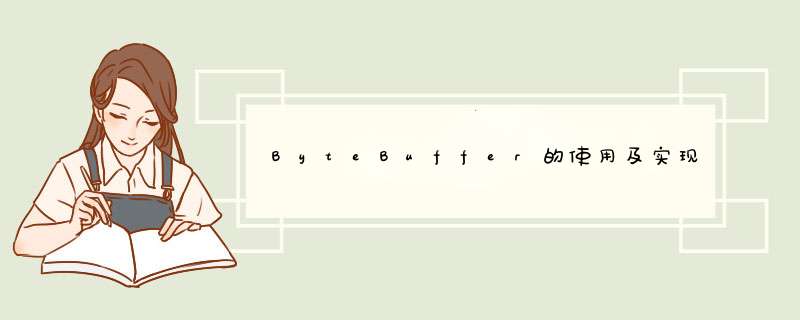
Buffer是nio包的一个抽象类,作为java nio的三大组件(Buffer、Channel,Selector)之一,在java nio网络编程中尤为重要。
Buffer提供了一个字节缓冲区,配合Channel使用,可以从Channel中读取或写入数据。
2、结构 属性介绍以ByteBuffer为例,其包括5个主要的属性:hb、position、limit、capacity、mark。
hb:ByteBuffer类有一个byte数组变量hb,此数组里面存放的就是实际的字节数据。
capacity:容量大小,其实就是hb字节数组的大小,始终不变。
position:当前读写 *** 作的ByteBuffer对象位置,其实就是hb字节数组下标位置。
limit:读写 *** 作position的大小限制,读写 *** 作时position需要小于limit。
mark:记录当前读写的位置,方便后续使用。
常用API方法/**
* 初始化指定大小的ByteBuffer对象返回。
*/
static ByteBuffer allocate(int capacity);
/**
* 使用指定字节数组初始化ByteBuffer对象返回。
*/
static ByteBuffer wrap(byte[] array)
/**
* 返回当前position位置的字节数据,position自增1。
*/
byte get();
/**
* 返回指定位置的数据。
*/
byte get(int index);
/**
* 当前position位置设置为传入字节,position自增1。
*/
ByteBuffer put(byte b);
/**
* 切换到读模式。
*/
Buffer flip();
/**
* 切换到写模式,不保留未读完数据。
*/
Buffer clear();
/**
* 切换到写模式,保留未读完数据。
*/
ByteBuffer compact();
- ①初始化状态。执行**ByteBuffer.allocate(10);**后状态。
- ②调用put方法插入数据,每往当前position位置插入一个数据,position执行加1 *** 作。插入4个数据后状态。
- ③调用flip方法,依次设置limit=position、position=0、mark=-1。
- ④调用get方法读取数据,返回当前position下标对应的值,然后positon执行加1 *** 作。读取三个数据后状态。
- ⑤调用clear或compact方法,重置position、limit的值。
调用clear后状态(依次执行position = 0、limit = capacity、mark = -1)。
调用compact后状态。
3、读模式和写模式其实ByteBuffer本身并没有读模式、写模式的概念,为了便于初学者理解网友们强加的概念。
flip、clear、compact等方法只是修改了position、limit、mark等属性的值而已,理解了上面的几个 *** 作图就不需要理解不存在的读模式、写模式,避免混淆理解。
4、使用演示- 演示1
/**
* 代码
*/
public class ByteBufferDemo {
public static void main(String[] args) {
ByteBuffer buffer = ByteBuffer.allocate(10);
buffer.put((byte)'a');
buffer.put((byte)'b');
buffer.put((byte)'c');
buffer.put((byte)'d');
System.out.println(buffer);
buffer.flip();
System.out.println(buffer);
System.out.println(buffer.get());
System.out.println(buffer.get());
System.out.println(buffer.get());
buffer.clear();
System.out.println(buffer);
System.out.println(Arrays.toString(buffer.array()));
System.out.println(buffer.get(2));
}
}
/**
* 运行结果
*/
java.nio.HeapByteBuffer[pos=4 lim=10 cap=10]
java.nio.HeapByteBuffer[pos=0 lim=4 cap=10]
97
98
99
java.nio.HeapByteBuffer[pos=0 lim=10 cap=10]
[97, 98, 99, 100, 0, 0, 0, 0, 0, 0]
99
- 演示二
/**
* 代码
*/
public class ByteBufferDemo {
public static void main(String[] args) {
ByteBuffer buffer = ByteBuffer.allocate(10);
buffer.put((byte)'a');
buffer.put((byte)'b');
buffer.put((byte)'c');
buffer.put((byte)'d');
System.out.println(buffer);
buffer.flip();
System.out.println(buffer);
System.out.println(buffer.get());
System.out.println(buffer.get());
System.out.println(buffer.get());
buffer.compact();
System.out.println(buffer);
System.out.println(Arrays.toString(buffer.array()));
System.out.println(buffer.get(2));
}
}
/**
* 运行结果
*/
java.nio.HeapByteBuffer[pos=4 lim=10 cap=10]
java.nio.HeapByteBuffer[pos=0 lim=4 cap=10]
97
98
99
java.nio.HeapByteBuffer[pos=1 lim=10 cap=10]
[100, 98, 99, 100, 0, 0, 0, 0, 0, 0]
99
- 演示三
/**
* 代码
*/
public class ByteBufferDemo {
public static void main(String[] args) {
byte[] bytes = {(byte) 'a', (byte) 'b', (byte) 'c', (byte) 'd', (byte) 'e', (byte) 'f', (byte) 'g'};
ByteBuffer buffer = ByteBuffer.wrap(bytes);
System.out.println(buffer);
System.out.println(Arrays.toString(buffer.array()));
//直接读取数据
System.out.println(buffer.get());
System.out.println(buffer);
//写入数据
buffer.put((byte)0x01);
buffer.put((byte)0x02);
System.out.println(buffer);
System.out.println(Arrays.toString(buffer.array()));
}
}
/**
* 运行结果
*/
java.nio.HeapByteBuffer[pos=0 lim=7 cap=7]
[97, 98, 99, 100, 101, 102, 103]
97
java.nio.HeapByteBuffer[pos=1 lim=7 cap=7]
java.nio.HeapByteBuffer[pos=3 lim=7 cap=7]
[97, 1, 2, 100, 101, 102, 103]
欢迎分享,转载请注明来源:内存溢出

 微信扫一扫
微信扫一扫
 支付宝扫一扫
支付宝扫一扫
评论列表(0条)